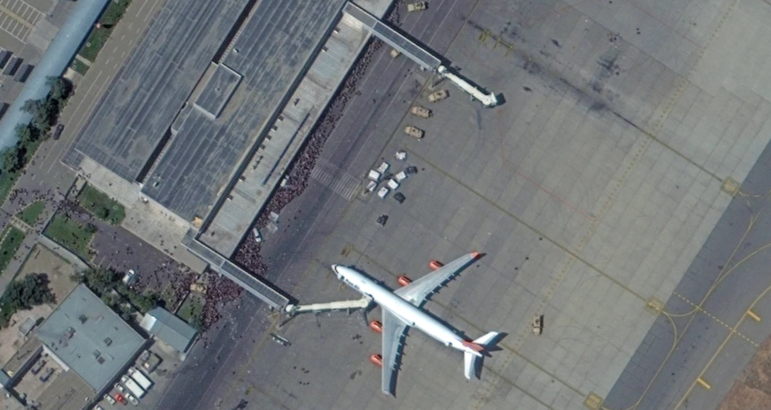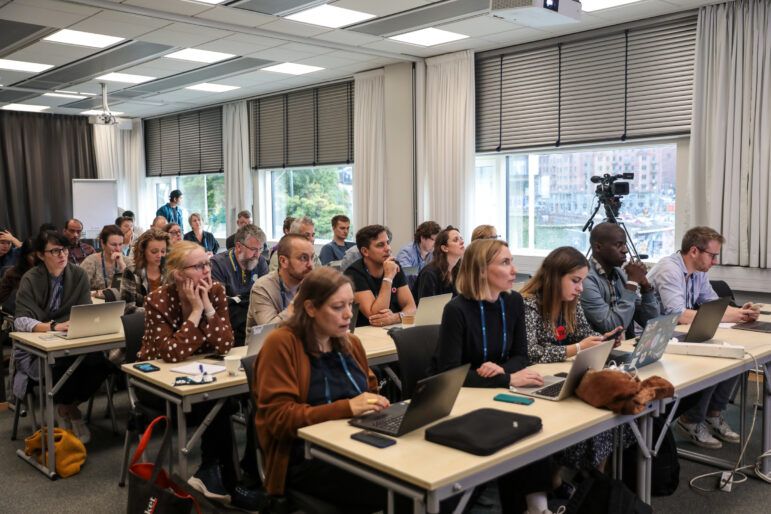

Data Journalism Top 10: Chaos in Kabul, Heat Deaths, Earth’s Biomass, Mapping Global Wildfires, Smearing the Greens
Read this article in
Nations are racing to evacuate people from Afghanistan while experts worry that the ongoing crisis may cause a humanitarian disaster. Our NodeXL mapping from August 16 to 22, which tracks the most popular data journalism stories on Twitter, found maps by The New York Times and The Washington Post showing the chaos at Kabul airport as thousands of Afghans try to flee the Taliban. In this edition, we also feature an investigation into heat-related deaths by NPR and Columbia Journalism School, a look by CORRECTIV at a mysterious poster campaign attack on Germany’s Green party, and a comprehensive visualization of Earth’s biodiversity.
The Dangerous Road Out
More than 70,000 people have so far been evacuated from Afghanistan and thousands more are looking to flee the country now controlled by the Taliban. Using satellite imagery, The New York Times showed how Taliban fighters occupy the space outside the airport in Kabul, blocking entrances and attacking civilians. The Washington Post took a similar approach capturing from above the desperate struggle of large crowds gathering around airplanes and trying to escape.
Mapping South Africa’s Vaccine Sites
South Africa’s vaccination campaign is just getting started, with only 13% of the country’s adults fully vaccinated. But those based in the country who want the jab can explore this comprehensive map showing active vaccination sites. The map was created thanks to a collaboration between the Bhekisisa Centre for Health Journalism and Media Hack, and is based on data from the South African health department’s coronavirus website.
Smearing the Greens
As Germany gears up for elections next month, some 3,500 posters mysteriously appeared in at least 50 cities, all aimed at smearing the record of the country’s Green Party. Research by investigative nonprofit CORRECTIV found that the posters — which label the party “totalitarian, socialist, hostile to the homeland” — were distributed evenly across the country and could have a real impact on the Green Party’s electoral chances.
Inside Greece’s “Top Employer”
Aegean Airlines, Greece’s largest airline a leading carrier in Southeast Europe, has spent years building a reputation as a top employer and industry leader. But an investigation by Reporters United, a Greek nonprofit journalism network, has found issues with how the company treats its staff as well as employment policies resembling those of low-cost airlines. Reporters examined data from the airlines’ annual report to show that in 2020 the carrier cut hundreds of jobs, primarily among its young, female workforce.
Hospital Bills
In the United States, the federal government has ordered hospitals to begin disclosing prices negotiated with private insurers, but many hospitals won’t comply. The New York Times analyzed data from hospitals that did reveal prices, and found out why the reluctance: some health insurers negotiated “surprisingly unfavorable rates for their customers.”
When Heat Exposure is Deadly
At least 384 workers in the US have died from environmental heat exposure in the last decade, according to an investigation by NPR and Columbia Journalism School’s investigative unit. The team analyzed two data sets from the Labor Department alongside workplace inspection reports, death investigation files, and other documents. Their investigation found that the authorities rarely penalize companies for such accidents.
Urban Heat in Asia
High temperatures are also a major issue in Asian cities where not everyone has access to the tree cover that can protect us from extreme heat. A piece in the Kontinentalist explains why green spaces are key in the fight against global warming, with communities in neighborhoods with low tree density also breathing more polluted air — and experiencing more health problems.
Global Wildfires
Reports about devastating wildfires around the world, including those that have swept through Mediterranean countries, North America’s West Coast, Siberia, and elsewhere have dominated headlines in recent weeks. Al Jazeera examined data from low-orbit satellites gathered by the European Space Agency and NASA to map the biggest wildfire disasters and demonstrate their destructive impact on communities.
Carrying the NBA Finals
Basketball is a team sport, but sometimes one player can carry a team to victory. Take, for example, the history of NBA Finals. The Pudding’s Russell Goldenberg took a data-driven approach to examine the biggest “carry jobs” in decisive NBA clashes. LeBron James came out on top with his performance as a Cleveland Cavaliers player in the 2018 Finals (although despite his effort, the Cavs lost to the Golden State Warriors.)
The Biomass of Life
In this series, along with groundbreaking data reporting, we sometimes feature exceptional data visualization projects. This week, we highlight a remarkable piece by graphics journalist Mark Belan who designed this detailed chart visualizing the biomass of all life on planet Earth. The graphic features data from a recent study and aims to make readers appreciate the scale of diversity on our planet, home to over 8.7 billion species.
Thanks again to Marc Smith and Harald Meier of Connected Action for gathering the links and graphing them. The Top Ten #ddj list is curated weekly.
 Peter Georgiev is GIJN’s social media and engagement editor. Previously, he was part of NBC News’ investigative unit in New York. He also worked as a correspondent for Bulgarian National Television and his reporting has been published by the Guardian, Deutsche Welle, and other international outlets.
Peter Georgiev is GIJN’s social media and engagement editor. Previously, he was part of NBC News’ investigative unit in New York. He also worked as a correspondent for Bulgarian National Television and his reporting has been published by the Guardian, Deutsche Welle, and other international outlets.









